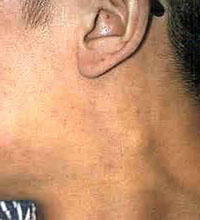21.4.1 Persistent generalised lymphadenopathy (PGL)
Persistent generalised lymphadenopathy (PGL) is a chronic swelling of the lymph nodes in at least two areas of the body outside the groins, which lasts three months or longer. PGL is common in the neck and underarm areas, as shown in Figure 21.1. Up to half of PLHIV show PGL at one point during disease progression. In some instances, PGL is present even if they are in the early stages of the disease (asymptomatic stage), i.e. when the patient has relatively good immunity. PGL results from a reaction of the patient’s immune system against the virus entering the body and establishing a chronic infection. You should reassure a person living with HIV that this sign does not affect their overall health.

21.4 Common opportunistic clinical manifestations in people with HIV
